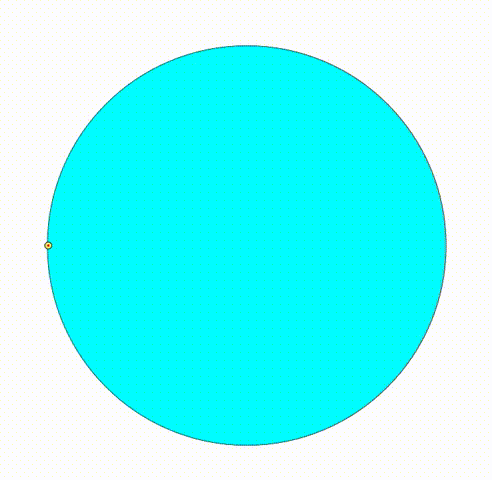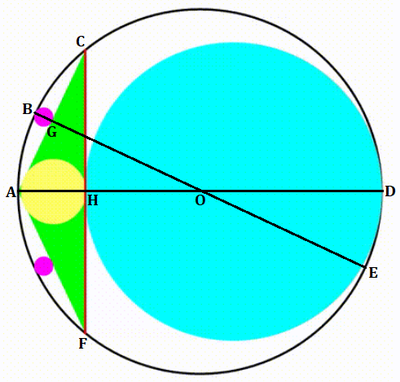Dynamic Geometry: P102
 The diagram shows a black circle with radius
1
. A vertical red chord moves horizontaly, creating two circular segments. We inscribe the largest possible circle (in cyan) in one of them and a green isosceles triangle in the other, we draw its incircle in yellow. A purple circle is the largest circle we can inscribed in one circular segment created by the green triangle. When the radii of the blue circle, the yellow incircle and one purple circle are in geometric progression (in that order from largest to smallest), the yellow incricle's radius can be expressed as
q
p
, where
p
and
q
are coprime positive integers. Find
q
−
p
.
The diagram shows a black circle with radius
1
. A vertical red chord moves horizontaly, creating two circular segments. We inscribe the largest possible circle (in cyan) in one of them and a green isosceles triangle in the other, we draw its incircle in yellow. A purple circle is the largest circle we can inscribed in one circular segment created by the green triangle. When the radii of the blue circle, the yellow incircle and one purple circle are in geometric progression (in that order from largest to smallest), the yellow incricle's radius can be expressed as
q
p
, where
p
and
q
are coprime positive integers. Find
q
−
p
.
The answer is 5.
This section requires Javascript.
You are seeing this because something didn't load right. We suggest you, (a) try
refreshing the page, (b) enabling javascript if it is disabled on your browser and,
finally, (c)
loading the
non-javascript version of this page
. We're sorry about the hassle.
2 solutions
Label the diagram as follows:

Let k = A H . Then H D = A D − A H = 2 − k , so that the radius of the blue circle is R b = 2 1 H D = 1 − 2 1 k .
△ A H C ∼ △ C H D , so C H A H = H D C H , or C H k = 2 − k C H , which solves to C H = k ( 2 − k ) .
By the Pythagorean Theorem on △ A H C , A C = A H 2 + C H 2 = k 2 + k ( 2 − k ) = 2 k .
As an incircle of △ A C F , the radius of the yellow circle is R y = P △ A C F 2 A △ A C F = A C + A F + C F 2 ⋅ 2 1 ⋅ A H ⋅ C F = 2 k + 2 k + 2 k ( 2 − k ) k ⋅ 2 k ( 2 − k ) = k − 2 + 4 − 2 k .
If R p is the radius of the purple circle, then by the intersecting chords theorem, B G ⋅ G E = A G ⋅ G C , or 2 R p ( 2 − 2 R p ) = 2 2 k ⋅ 2 2 k , which rearranges to R p = 2 1 − 4 1 4 − 2 k .
When the radii of the blue, yellow, and purple circles are in a geometric progression, R b ⋅ R p = R y 2 , or ( 1 − 2 1 k ) ( 2 1 − 4 1 4 − 2 k ) = ( k − 2 + 4 − 2 k ) 2 , which solves to k = 3 2 1 5 for 0 < k < 2 .
Therefore, the radius of the yellow circle is R y = 3 2 1 5 − 2 + 4 − 2 ⋅ 3 2 1 5 = 3 2 7 , so p = 7 , q = 3 2 , and q − p = 5 .
Thank you for posting.
Let the center of the unit circle be O , its diameter perpendicular to the red chord C D be A B , A B and C D intersect at E , the radii of the cyan, yellow, and purple circles be r 1 , r 2 , and r 3 respectively, ∠ C O B = θ then ∠ C A O = 2 θ , and t = tan 2 θ .
Then r 1 = 2 B E = 2 1 − cos θ = 2 1 − 1 + t 2 1 − t 2 = 1 + t 2 t 2 .
Let P be the center of the yellow circle and P F be perpendicular to A C . Then
A E 2 − 2 r 1 2 − 1 + t 2 2 t 2 ⟹ r 2 = A P + P E = F P ⋅ csc 2 θ + P E = r 2 csc 2 θ + r 2 = r 2 ( t 1 + t 2 + 1 ) = 1 + t 2 2 t ( 1 + t 2 − t )
Let G and H be the tangent points between the top purple circle and the unit circle, and the triangle respectively. Then
G H + H O G H + A O ⋅ sin 2 θ 2 r 3 + sin 2 θ ⟹ r 3 = G O = G O = 1 = 2 1 + t 2 1 + t 2 − t
When the three radii are in a geometric progression, we have
r 1 r 3 1 + t 2 t 2 ⋅ 2 1 + t 2 1 + t 2 − t 2 1 + t 2 1 1 + t 2 8 t 1 + t 2 8 t 6 4 t 2 ⟹ t ⟹ r 2 = r 2 2 = ( 1 + t 2 ) 2 4 t 2 ( 1 + t 2 − t ) 2 = 1 + t 2 4 ( 1 + t 2 − t ) = 8 ( 1 + t 2 ) − 8 t 1 + t 2 = 7 ( 1 + t 2 ) = 7 1 + t 2 = 4 9 + 4 9 t 2 = − 1 5 7 = 1 + 1 5 4 9 1 5 1 4 ( 1 + 1 5 4 9 − 1 5 7 ) = 3 2 7 Since θ > 1 8 0 ∘
Therefore q − p = 3 2 − 7 = 5 .